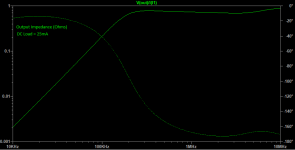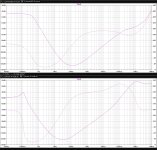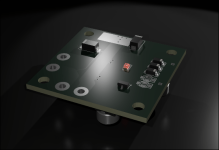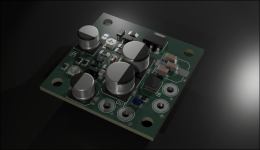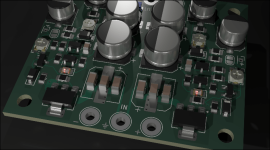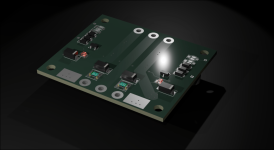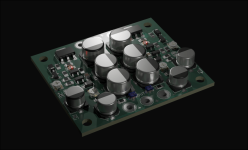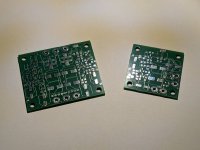And this is the more evolved, 154dB@100Hz variant. Some work will be necessary on the two compensation capacitors. Note that not all the protection components have to be present in all situations; depending on the context, some might be dispensed with (and it applies to the two variants), but as drawn they should be reasonably bullet-proof.

Attachments
One more remark: none of the circuits presented has been tested in reality, and the fact that they appear to work in sim says nothing of their real world performance.
Stability aspects in particular could prove especially tricky...
Stability aspects in particular could prove especially tricky...
A looking at stability, switching V1 to DC 420V and hanging an AC1 current, I1 on the output (with 25mA DC load). This graph is from 10kHz to 10MHz. Looks pretty stable to me. (This is the non-invasive analysis method from Omicron-Lab, https://www.omicron-lab.com/applica...tional-and-non-invasive-stability-measurement )
The impedance troughs around 10 microOhms at ~100Hz which is impressive.
The impedance troughs around 10 microOhms at ~100Hz which is impressive.
Attachments
Or a CCS (JFET) in the place of the resistor R5. [I did that with following Darlington. Initially also intended as slow-start-up...] - I'm late to the party I see. I was asleep for a long time. Really.Why no Zener diode at the base of Q1? It will increase mains ripple rejection ("PSRR at low frequencies") by many decibels.
Am I wrong or there's a slight displacement to the left and up, to the impedance curve in LTSpice after these changes are made to the original Diego's regulator? Psrr is not affected, and noise we can't get reliable results of.I have used a Dienoiser in the sensitive section of a frequency synthesizer, and I noticed that for 6V the values from the table published by Diego are not optimal.
This is the modified circuit:
View attachment 1295143
With the original values, the the Vce of Q1 was <1V, which is not very healthy: the transistor works in quasi-saturation mode, and the possible correction amplitude is limited.
With R3 at 470 ohm instead of 1K2 and R5 connected differently, the collector voltage is more reasonable, and the current through Q1 is higher, which is beneficial for the noise performance
Attachments
Yes, having the modifications slightly altering the behaviour is normal, and not really catastrophic. Better to have a circuit that works well in reality than a beautiful sim
Couldn't agree more, and I know there's nothing catastrophic in it. Diego always said that his circuit needed specific adjustments, slight ones, to make it work as it should. The long time since I don't use LTSpice and my failing memory on electronic matters made me forget how to simulate impedance in ohms. Could you refresh it?
I managed to design and order full SMD single and dual boards. They have alternative LED footprints on the backside and can be configured LC/RC or fuse and C input.
Should work for 5-30Vout. SOT223 package is rated for 1W so 200-300mA should be fine.
Need to order some parts for testing, hope I can find the stubby output caps (35V rating). Else they'll be a bit taller. And I also need to test them, final design might change a bit.
Should work for 5-30Vout. SOT223 package is rated for 1W so 200-300mA should be fine.
Need to order some parts for testing, hope I can find the stubby output caps (35V rating). Else they'll be a bit taller. And I also need to test them, final design might change a bit.
Attachments
You're a little too tight on clearance towards the board edge at the output connectors. The traces are pretty flimsy to begin with (beef them up to 25-50mil if space allows), and the one on the smaller board already looks damaged on the photo. Better find another way to route them away from the board edges in your next revision - and allow some more space to make them wider.
Want to get some help on using the denoiser with LM317HVT (can use normal LM317, but want to support both AC source (~39V) and 6x9V battery at the same time, which is 57.6V max at the input voltage) to regular down to 35V for a project. The load need only 25ma and about 100ohm impedance.
When using the LTSpice to see if it will work or not i got strange voltage output:

The output is not a sine wave (V2 sine noise source), looking like it is clipped.
I have check using Elvee orginal .asc file of the RH117H model it is the same result with the clipper non sine wave output(just slight lower output voltage).
If I disconnect the DeNoiser, the output look normal as the sine wave again.
I have adjust R4/R5 resistor to keep the current around 6-7ma for Q1 in DeNoiser when the output is 35V. (Have check if using original vales 1K8/180K, same clipped result too).
Have read early post, the DeNoiser should work with 35V just the denoise performance may be not optimal, and the C2 and C4 (C5 and input cap if any) need higher voltage rating. I don't mind change BC337 to ZTX as ZTX is rated at 60V, but I check Vce of Q1 is about 7V currently.
Did I do anything wrong with the sim? Or DeNoiser cannot regulate higher voltage (35V) with LM317? Or if the the above schematic having issue (wrong value)?
Thanks in advance.
When using the LTSpice to see if it will work or not i got strange voltage output:
The output is not a sine wave (V2 sine noise source), looking like it is clipped.
I have check using Elvee orginal .asc file of the RH117H model it is the same result with the clipper non sine wave output(just slight lower output voltage).
If I disconnect the DeNoiser, the output look normal as the sine wave again.
I have adjust R4/R5 resistor to keep the current around 6-7ma for Q1 in DeNoiser when the output is 35V. (Have check if using original vales 1K8/180K, same clipped result too).
Have read early post, the DeNoiser should work with 35V just the denoise performance may be not optimal, and the C2 and C4 (C5 and input cap if any) need higher voltage rating. I don't mind change BC337 to ZTX as ZTX is rated at 60V, but I check Vce of Q1 is about 7V currently.
Did I do anything wrong with the sim? Or DeNoiser cannot regulate higher voltage (35V) with LM317? Or if the the above schematic having issue (wrong value)?
Thanks in advance.
Why do you want a sine wave at the output to begin with? The DeNoiser is there to get rid of any...
V2 is only needed as a stimulus for AC simulations; set it to 0V (or remove it altogether) for transient simulations.
V2 is only needed as a stimulus for AC simulations; set it to 0V (or remove it altogether) for transient simulations.
I just try see if the DeNoiser able to handle the 35V output (low load), and if the R4/R5 need to adjust for Q1 when using it at 35V output. Of course I dont want the sine wave output, and want the denoiser to remove it as much as possible.
May be the simple question I should ask is, can the LV's DeNoiser use with LM317/LM317HV at 35V output. Any adjustment need to make apart from making sure all cap is rated at correct voltage.
May be the simple question I should ask is, can the LV's DeNoiser use with LM317/LM317HV at 35V output. Any adjustment need to make apart from making sure all cap is rated at correct voltage.
What you see is probably a sim artifact: the DC conditions are not possible, unless an oscillation is present, but it rarely appears in sim.
It is easy to check: probe the collector of the transistor for parasitic HF.
Otherwise, try to tweak the sim, change the initial conditions, etc.
It is easy to check: probe the collector of the transistor for parasitic HF.
Otherwise, try to tweak the sim, change the initial conditions, etc.
Thanks Elvee for your effort to release the DeNoiser and shape the whole X-noisers familes.
So for use it for 35V LM317 output. Do we need to change anytthing on your denosier schematic at #537. ie R4/R5 or C2?
So for use it for 35V LM317 output. Do we need to change anytthing on your denosier schematic at #537. ie R4/R5 or C2?
Just curious, with 100 ohm and 35 V you get 350 mA?The load need only 25ma and about 100ohm impedance.
The changes you already made look sufficient.So for use it for 35V LM317 output. Do we need to change anytthing on your denosier schematic at #537. ie R4/R5 or C2?
Did you probe the collector of the transistor?
- Home
- Amplifiers
- Power Supplies
- D-Noizator: a magic active noise canceller to retrofit & upgrade any 317-based VReg
